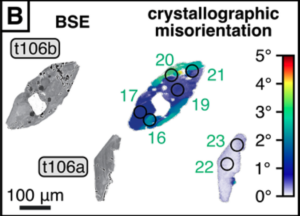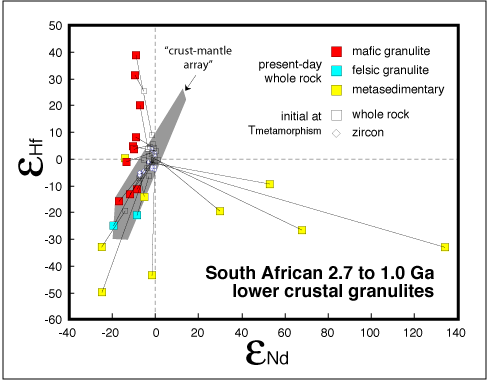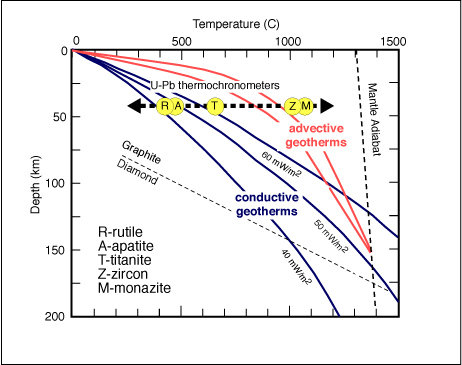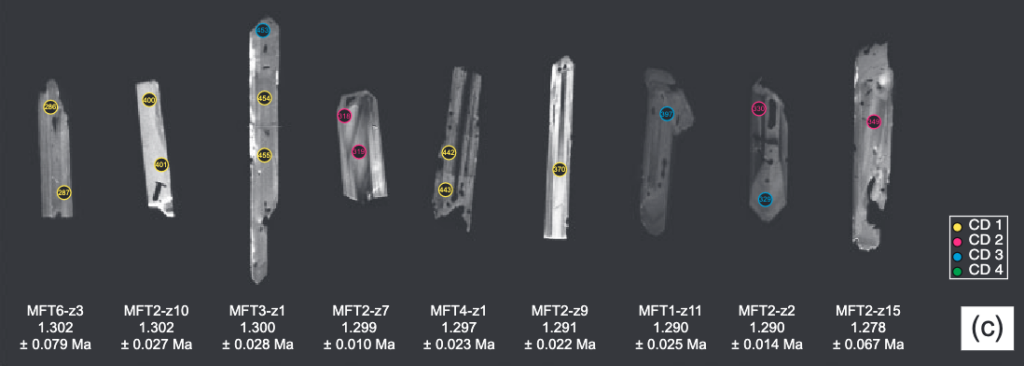The tabs below describe some of my active research projects in the application of isotope geochemistry and geochronology to a wide variety of problems in the geosciences. All of these projects engage students in the research endeavor; prospective students are encouraged to contact me for more details.
About Research Projects

Paleoclimate
Green River Early Eocene Climatic Optimum
We are applying high-precision geochronology and innovations in Bayesian age modeling techniques through a large collaborative project focused on the paleolacustrine rock archive of the Green River Formation, and its paleoclimate record. We are working collaboratively with other geochronologists, astrochronologists, sedimentologists, and paleoclimatologists to create a high-resolution age model through this record of the Early Eocene Climatic Optimum between 51 and 49 Ma. Recent outcomes have included a new Bayesian age model for the Wilkins Peak Member of the Green River Formation based upon new high-precision U-Pb zircon geochronology of ash beds throughout the sequence, which has affirmed the eccentricity forcing of hydroclimate and sedimentation through the sequence. This project has also supported a new methodology for joint inversion of astrochronology and radioisotope geochronology, which can be applied in the future to a variety of sequences across geologic time.
Pacific Northwest Paleobotany in the Mid-Miocene Climatic Optimum
Student opportunities are available to work within a large collaborative project focused on the paleolacustrine rock archives of the Miocene of the Pacific Northwest, and paleoclimate proxy records of the Mid-Miocene Climatic Optimum. We are working collaboratively with paleobotanists studying macroflora, pollen, and phytoliths to create a high-resolution age model through this record of the Mid-Miocene Climatic Optimum between 17 and 14 Ma.

Stratigraphy
Cambrian Earth Systems
Rocks from the Cambrian Period (539-485 million years ago) record dramatic changes in Earth systems including atmospheric oxygenation, large magnitude perturbations to the carbon cycle, and the ‘Cambrian Explosion’ of animal life, all within a series of transgressions of sea level onto continental margins across the ‘Great Unconformity’. The geological ‘drama’ of these events was accentuated at the end of the 20th century with the first application of U-Pb zircon geochronology to the Precambrian-Cambrian (Bowring et al., 1993; Grotzinger et al., 1998) and Cambro-Ordovician boundaries (Davidek et al., 2000). The subsequent integration of carbon isotope stratigraphy and radioisotopic geochronology led to a framing of the lower Cambrian (Terreneuvian) explosion of animal diversity and disparity (Amthor et al., 2003; Maloof et al., 2010; Linnemann et al., 2018), however remarkably few opportunities for further calibration of the Cambrian have presented themselves until recently.
Southwest Laurentia holds key records of Cambrian environments in strata of the Wood Canyon Formation of the southern Great Basin (SE California and S Nevada), the Tonto Group of the Grand Canyon region, and related Cambrian sheet sands exposed from southern Arizona and New Mexico to northern Utah. These successions hold a rich paleontological and biogeochemical record of nearly the entire Cambrian, and yet due to a lack of dateable volcanic horizons these records have not played a significant historical role in understanding the timing and tempo of Cambrian Earth systems. In this lecture I’ll review how an interdisciplinary group of scientists have unlocked the potential of these sections using tandem in situ and isotope dilution U-Pb geochronology of detrital zircons and novel Bayesian age models schemes that can incorporate diverse stratigraphic and geochronologic likelihoods.
From new constraints on the Precambrian-Cambrian boundary (Nelson et al., 2023), to the overturn of trilobite biomeres (Karlstrom et al., 2020; Sundberg et al., 2020), to the calibration of major carbon isotope excursions (Cothren et al., 2022), this new age model for Laurentian strata and fossils is directly relatable to the global time scale, and results in reallocations of time within the Cambrian Period that have implications for the tempo of biological change and perturbations to the carbon cycle (Farrell et al., 2025). Our work further documents how the tempo and accommodation of the classic ‘Sauk sequence’ sea level transgressions across the western Laurentian margin were heavily influenced by local rift-related faulting and base-level changes, in addition to global eustasy via far-field tectonic processes.
Late Carboniferous – Early Permian marine and terrestrial chronostratigraphy
The Late Pennsylvanian through Early Permian was an important interval in Earth’s history; significant events of this age include the final assembly and early evolution of Pangea, major eustatic changes in sea level, and global climate change from the Pennsylvanian ice house to the Permian hot house.
Because many fundamental aspects of geologic research (supercontinent assemby, changes in paleobiological diversity, climate change and cyclicity) depend directly on the accuracy and precision of the geologic time scale, improving its age calibration is critical and requires a robust, well constrained, and internally consistent framework of biostratigraphic and geochronologic data for the Late Carboniferous and Early Permian. By combining U-Pb zircon ash bed geochronology with a strong foundation of biostratigraphic expertise, the Late Paleozoic working group at Boise State University has calibrated this interval of the time scale using the type and principle reference sections in the southern Ural foreland of Russia-Kazakhstan.
Over the past decade we have been leveraging U-Pb zircon geochronology to extend beyond marine to paralic cyclothem records into more complex terrestrial records of paleoflora, fauna, sedimentology, and proxy records of paleoclimate, in order to extract details of ice volume and global to regional hydroclimate during these evolving icehouse climate states, as well as refine the correlations and trends in terrestrial paleobiological innovation and evolution.
Late Devonian biotic crises
The Late Devonian period hosts a series of global biological extinction events of such magnitude as to be counted among the major mass extinctions of the Phanerozoic. Yet no consensus has yet been reached regarding the causative mechanisms of extinction and associated changes in marine sedimentation, biogeochemical cycling, sea level and climate. Testing of competing hypotheses for Late Devonian extinctions?which include sea-level fluctuations and regression, climatic cooling, ocean anoxia, bolide impact, and/or massive volcanism is currently hampered by a lack of sufficient temporal resolution in paleobiological, tectonic and proxy climate records.
In this study, a multi-disciplinary research team of paleontologists, biostratigraphers and isotope geochemists (Drs. Vladimir Davydov and Mark Schmitz of Boise State University, and Dr. Jeffrey Over of SUNY-Geneseo) combined high-precision U-Pb zircon geochronology on interstratified volcanic ash beds in key stratigraphic successions with quantitative biostratigraphy applied to a global Late Devonian multi-taxa database compiled from the literature and new high-resolution sampling. The U-Pb geochronology utilizes the chemical abrasion and EARTHTIME double spike isotope dilution methods to measure ca 0.1 Ma resolution ages, and the construction of the first highly resolved composite standard for the Late Devonian via constrained optimization. With this high resolution age model the research team is interrogating several fundamental questions relating to the abruptness of the late Devonian biotic events, their global synchrony, and process drivers. Specific hypotheses being addressed include the synchrony and causality between extraterrestrial impacts or massive volcanism and biotic crises, whether the rates of associated eustatic rise and fall and fluctuations in proxy records of carbon cycling and temperature are consistent with Milankovich-band orbital forcing, and if feedbacks between climate, glacioeustasy, ocean anoxia, and the carbon cycle caused the Late Devonian biotic crises.
Neoproterozoic glaciations
A number of profound glaciations punctuated Neoproterozoic Earth history, accompanying major changes in biogeochemical cycles and the evolution of multi-cellular life. The ‘Snowball Earth’ hypothesis has galvanized broad interest in Neoproterozoic geology, but remains controversial largely due to uncertainty about the timing, duration, and initiation mechanism of global glaciation. With previous and preliminary studies, we have demonstrated that the age of Sturtian glacial deposits in the Yukon is indistinguishable from the age of the Franklin large igneous province (LIP), which was emplaced on the eastern margin of Laurentia, in the tropics, in an ideal position for being chemically weathered. This is intriguing, because basalt is more weatherable than average continental crust, and it has been proposed that Snowball Earth events were initiated by an increase in weatherbility and a concomitant increase in CO2 consumption. Our recent work has narrowed the age range and error bars on the Franklin LIP into a short-lived event whose main pulse of volcanism precede the onset of the Sturtian glaciation by 2-3 million years, consistent with the basalt weathering trigger hypothesis. We continue to pursue integrative stratigraphic studies that constrain the timing and duration of the Cryogenian glaciations, LIP magmatism, and key paleobiological and biogeochemical proxy records with high resolution U-Pb ID-TIMS dating of magmatic zircons and LA-ICPMS dating of detrital zircons.

Tectonics
Deformation and magmatism in continental arcs through titanite petrochronology
Mountain ranges form when the Earth’s crust contracts due to the collision of tectonic plates. This contraction generates granite plutons in the crust and deforms those granite plutons through shear zones (localized regions of intense deformation). Both processes imprint a ‘fabric’ on the granite, an arrangement of minerals that records the deformation of the rock. The mineral titanite crystallizes during the formation of granite in the crust and during the formation of rock fabric, and both events can be dated using the radioactive decay of uranium into lead within titanite crystals. This new method for dating shear zones will be used to examine mountain building processes and the development of rock fabrics that subsequently can control further magma emplacement, faulting, fluid flow, and metal ore mineralization.
This study established the physical and chemical changes in the mineral titanite during deformation. Structural geology techniques document the physical changes through the outcrop and microscale structures of the rock, and electron microscopy quantifies the recrystallization of individual mineral grains. Chemical changes in titanite are measured by X-ray and mass spectrometry techniques, and individual crystals are dated using measurements of uranium-lead isotope ratios with both in situ (LA-ICPMS) and isotope dilution (ID-TIMS) mass spectrometry. These techniques have been applied in two study areas, in shear zones in western Idaho and east-central California. Rocks from these areas show a wide range of fabric development, from non-deformed to pervasively sheared. The variety of degrees of deformation measured through the methods described above have been used to track how the intensity of a rock fabric develops during shear zone movement. Outcomes in both study areas have included methodologies to establish sub-million year resolution of the timing of deformation, the spatial-temporal pattern of strain accumulation within shear zones, and the feedbacks between magmatism and deformation.
Accreted terranes of the northern U.S. Cordillera
In the late Permian through Jurassic a number of volcanic arcs and associated sedimentary packages were accreted to the Precambrian margin of western North America. I have had several student projects exploring the evolution of these Mesozoic arcs and their record of continental growth.
Petrology
Tempo of silicic magma generation, storage and differentiation—from small-volume domes to Yellowstone super-eruptions
The application of petrochronology – integrated textural, geochemical, thermometric, and geochronologic analysis – to silicic volcanic systems seeks to yield insights into the mechanisms and timing of magma generation, differentiation, and eruption. Analytical advancements over the last decade have improved the precision, and thus the temporal resolution, of the U/Pb zircon and Ar/Ar sanidine dating techniques, particularly for Neogene eruptions. Increased precision has in turn revealed greater dispersion in the apparent ages of the crystal cargo of silicic magmas. The petrochronological approach posits that by combining high-precision geochronology with geochemical and isotopic information from the same dated grains we can achieve a better resolution of the processes contributing to these complexities for crystals and their host magmas.
The Yellowstone volcanic system is best known for its three super-eruptions: the 2.1 Ma Huckleberry Ridge Tuff (HRT), the 1.3 Ma Mesa Falls Tuff (MFT), and the 0.6 Ma Lava Creek Tuff (LCT). We seek to test the end-member hypotheses that super-eruptions are: 1) the culmination of gradual magma accumulation periodically tapped by precursor eruptions; or b) the distinctive products of punctuated episodes of high magmatic flux. Our proposed study examines the MFT magmatic cycle. A reconnaissance petrochronologic evaluation of the MFT shows that several pulses of zircon growth occurred prior to the super-eruption. However, uncertainty arises as to the origin of the various older crystal modes, specifically whether they are the sparse record of MFT magma accumulation, or recycled from earlier magma batches unrelated to MFT magmatism. Answers to these questions likely lie within the Big Bend Ridge rhyolites that erupted prior to the MFT. These rhyolites consist of several independently erupted small-volume silicic magmas, but the timing and process of formation of each is poorly constrained, and the contribution of these magmas to the MFT super-eruption is unknown. We propose that a petrochronologic evaluation of the Big Bend Ridge pre-caldera rhyolites will test the links between small-volume eruptions and subsequent super-eruptions. We will accomplish this evaluation using geochemical and isotopic information obtained by in situ LA-ICPMS on imaged zircon crystals, CA-IDTIMS U/Pb dating of the same grains, and Ar/Ar dating of sanidine crystals using a new generation multi-collector noble gas mass spectrometer.
This work will advance knowledge by contributing to the understanding of the mechanisms in which Yellowstone-type magmas are generated, the timescales of magma generation preceding a super-eruption, and the eruption recurrence intervals within the Yellowstone volcanic system. The results of our study will bear directly upon the general question of the active lifespans of eruptible magmas beneath large silicic magmatic centers.
Sm/Nd – Lu/Hf isotope fractionation during deep crustal processes

Another research project examines the application of combined Lu-Hf and Sm-Nd systematics to problems of intra-crustal differentiation through metamorphism and partial melting. High grade metamorphic reactions and associated partial melting in the middle to lower crust may represent among the few possible venues and processes capable of decoupling the commonly correlated parent-daughter fractionation between these two systems. Thus their study and quantification may reveal a unique tracer for intra-crustal differentiation processes and perhaps even the recycling of deep crustal continental material into the convecting mantle. My work is focused on establishing the mineralogical and compositional controls on crustal Lu/Hf and Sm/Nd fractionation through the analysis of these isotopic systems in middle to lower crustal amphibolite to granulite rocks and minerals from of a variety of ages and tectonic settings.

Mantle Geochemistry
Diamond formation in the southern African continental lithosphere
The formation, stabilization and preservation of continental lithosphere provide our most direct record of the ancient evolution of the Earth. However, the complex mechanisms of these processes and their relationship to some ancient form of global tectonics are still incompletely understood. Integrative studies of the age and geochemistry of lithospheric mantle samples can be combined with advanced ideas on crust and mantle structure to further our understanding of the geological processes by which the oldest continental nuclei—the Archean cratons—were created. The Kaapvaal-Zimbabwe craton of southern Africa is an important remnant of one of the Earth?s earliest continents: it contains a rock record spanning _>_3.5 Ga; it has an emergent framework of high-precision geochronological constraints on its geotectonic evolution; it has abundant young kimberlite eruptions that have sampled the deeper continental lithosphere to provide a rich diamond and mantle xenolith suite; and it has active diamond mining to assure the steady availability of diamonds and xenoliths for study.
In particular, diamonds and their inclusions have provided unique constraints on the evolution of ancient continental lithospheric mantle, both by serving as the most robust capsules of geochronologic information in the mantle, and as indicators of the characteristically subdued thermal state and substantial thickness of the mantle keel beneath continents. The geochronology and geochemistry of inclusions in diamonds need to be systematically extended to evaluate new models of craton formation. With colleagues from the Department of Terrestrial Magnetism (Carnegie Institution of Washington) and the University of Cape Town (South Africa), we are conducting detailed studies of the growth history and geochemistry of diamonds from South Africa, using cathodoluminescence imaging, FTIR spectroscopy, and Re-Os geochronology and Pb isotope tracer studies of sulfide inclusions in diamonds. These results are being integrated with data from coexisting xenoliths and xenocrysts to establish the tectonic evolution of the Kaapvaal tectosphere.
The origin of mantle eclogites in the southern African tectosphere
Eclogite—the high pressure metamorphic equivalent of basalt—is a volumetrically minor (<1%) but geochemically and geodynamically important constituent of the subcontinental lithospheric mantle. Their importance for mantle dynamics stems both from their capacity as a major storehouse for incompatible element and isotopic tracers, as well as their direct petrogenetic linkage to shallow mid-ocean ridge and subduction zone processes. As the metamorphic equivalents of oceanic crust recycled back into the mantle, eclogites represent an integral link between the global tectonic cycle and deeper mantle convection.
Eclogite xenoliths in explosive volatile-rich alkaline magmas are sourced from the upper 250 km of the lithospheric mantle beneath the continents. In the case of kimberlite-borne eclogitic xenoliths, these small (cm to dm-sized) but important samples of the lithospheric mantle are generally erupted through ancient Archean to Proterozoic crust, and thus it is tempting to assume that they too represent a stored record of very ancient plate tectonic processes. However, robust ages for eclogitic components in the subcontinental lithospheric mantle (SCLM) remain elusive because of the complicating effects of high-temperature isotopic equilibration and open-system chemical and isotopic modification during mantle metasomatism.
In our examination of several eclogite xenolith suites from southern African kimberlites, we have discovered zircon as a trace (ppm-level) but relatively common accessory mineral. This mineral can provide an unprecedented look at the thermal and metasomatic evolution of the continental mantle.

Thermochronology
U-Pb accessory mineral thermochronology
The focus of this work is the application of high-precision U-Pb accessory mineral geochronology to suites of granulite-facies deep crustal rocks either as basement massifs or xenoliths in volcanics, with the goal of using the differential closure temperatures of a variety of accessory minerals to reveal the thermal history of the lower crust. The figure at right illustrates how the range of accessory mineral U-Pb closure temperatures (Tc) significantly overlaps that through which the lower crust evolves from conditions of high-grade metamorphic formation to the temperatures associated with stable cratonic geotherms.
Our earlier studies of lower crustal xenoliths from southern Africa have confirmed the prolonged timescales of isotopic closure of these U-Pb accessory minerals, and have been used to address the timescales of thermal equilibration of continental lithosphere, and provide constraints on the establishment and perturbation of steady-state geotherms in the continental lithosphere. This work has perhaps most dramatically illustrated the dynamic nature of the lower crust as it responds to orogenic and magmatic chemical and thermal inputs long after the stabilization of the upper crust. The application of U-Pb thermochronology to the deep lithosphere is an exciting new means of exploring the tectonic and thermal evolution of the continents, and one that may be applied to a variety of lower crustal xenolith suites beyond southern Africa.
